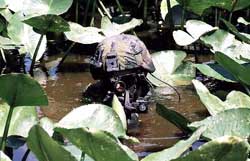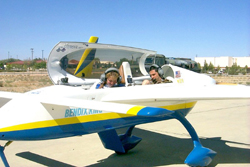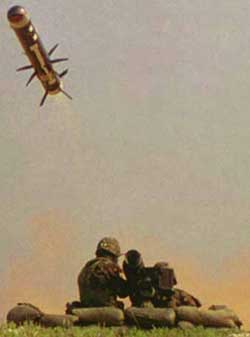Daily News
by Gail Helmer
[ Send Us News | Archives ]
EA has released the newest video from Medal of Honor: Allied Assault. This Part 3 of the four part series on Mission 5 Level 1 shows the deployment to the Brittany Peninsula in western France.
New Ghost Recon Screens
Ubi Soft has released new screens from the upcoming "Ghost Recon". "Ghost Recon" marks Red Storm's return to the 'Squad based tactical shooter' genre for the first time since 1999's Tom Clancy's Rogue Spear. Player's conduct extensive missions on foot, but you'll occasionally have assistance from troops in tanks, helicopters and close air support. Release Date: Q4, 2001. Click here for screenshots.
Ubi Soft has also announced the official minimum system requirements:
New Interview with Oleg Maddox
Ubi Soft has posted a new interview with IL-2 Sturmovik’s Oleg Maddox about his interests, his favourite games, and the computer industry. This is Part I of a two part series. Click here
ATK said it has been awarded a $14 million contract from the U.S. Army Armament Research, Development, and Engineering Center, Picatinny Arsenal, N.J., for the design, development, and production of the Army's Electronic Time Fuze for Mortars (ETFM).
Development work under the five-year contract will be conducted by ATK Precision Fuze Company, Janesville, Wis., at its design and development center in Hopkins, Minn. Production work will take place at the company's manufacturing plant in Janesville.
The ETFM will be incorporated into air-burst illumination and smoke cartridges for 60mm, 81mm, and 120mm mortars used by the U.S. Army and U.S. Marine Corps. It provides improved timing accuracy and enhanced safety, and can be set by hand without external illumination.
"We are pleased to be chosen by the Army to develop this advanced, highly accurate mortar fuze, which will bring greater mobility and safety to our soldiers and marines in tactical situations," said Blake Larson, president, ATK Precision Fuze Company. "With more than 50 years' experience in designing and producing fuzes, we understand their relationship to ordnance and their importance to our fighting troops. Our team is eager to apply this expertise to the ETFM program."
Phase II Funding for Land Warrior Program
Exponent, Inc., announced today that it has been awarded a follow-on contract with the United States Army for the development of the Army's Advanced Combat Soldier Uniform. Exponent is assessing off-the-shelf technologies for short and long-term advancements in the combat uniform. Areas where improvements will be focused include clothing fabrics and materials, chemical/biological barrier materials, and environmental and ballistic protection. Exponent will also investigate integrating clothing and electronics to monitor the physiological well-being of the soldier in combat. The contract, funded through the U.S. Army's Product Manager -- Soldier Equipment, extends through October 17th, 2001 and is expected to realize approximately $350,000 in net revenue for the firm.

Photo by Sarah Underhill
"We are pleased to have this contract in place, allowing us to continue to lead this exciting technology development program," said Michael R. Gaulke, President and CEO. "The success of the Land Warrior system has given Exponent the opportunity to support other military programs in using commercial off-the-shelf technologies in their applications, and we are pleased to have been selected to assist the Army in developing the soldier uniform of the future."
Future Air Force Test Pilots Continue Training
Several seniors at the U.S. Air Force Test Pilot School had the opportunity to try out a rather unique, built-from-scratch Long EZ aircraft at the school recently. Test Pilot School Commandant, Col. George Ka'iliwai, said that despite recent tragedies in New York and at the Pentagon, training at the school is continuing on schedule.
"TPS continues to train and fly our students because we're providing the Department of Defense with highly trained test pilots, flight-test navigators and flight-test engineers," Ka'iliwai said. "These highly trained flight testers will be the warfighting forces' representatives in the acquisition and development cycles of this nation's weapon systems. In turn, the president can use these systems to protect our national security."

The Long EZ, known to aviators for its fuel-efficiency and to air show enthusiasts for its acrobatic capabilities, offered students the chance to fly an experimental, civilian aircraft. Flying the canard-controlled, propeller-driven aircraft was a first for many of the pilots and flight test engineers attending the school.
To TPS faculty, the Long EZ flights are considered an experience broadener within the school's qualitative evaluation portion of the yearlong course. To the school's students, flying in the Long EZ is considered a "fun" ride.
"It was different from anything I had ever flown before," said Capt. Don Johnson, a student and experienced F-16 Fighting Falcon pilot. "The controls are very light and very sensitive which increases your maneuverability once you are airborne."
Like Johnson, Capt. Richard Bailey agreed that flying qualities of the Long EZ set it apart from other aircraft he has flown.
"My whole background has been in jet aircraft, so flying the Long EZ at 140 knots is a little different from flying at the usual 450 knots," said Bailey, a weapons system officer with experience in the F-15E Strike Eagle.
"Though we may never be conducting a flight test on a Long EZ, evaluating its flying characteristics helps to broaden our background to other types of aircraft that we might see at some point in our career," he said.
This is the second year owner Tom Staggs has flown his Long EZ to Edwards from his home near Seattle. Staggs has performed with the aircraft in several air shows across the country. While at Edwards, he serves as the students' instructor for the week participating in preflight briefings and accompanying students on their flights.
Staggs said he could tell the students enjoyed their time in the Long EZ. "This year's students are very motivated to learn about flying different types of aircraft," Staggs said.
UK Mod Launches Competition For New Anti-Tank Missile
Two international consortia have been invited to compete for a contract worth in excess of Ł300 million to supply Britain's Armed Forces with a new "fire and forget" anti-armour guided missile system.
The new weapon, which will replace the existing MILAN anti-tank missile system, will enter service in 2005 with rapid reaction forces including 16 Air Assault Brigade, 3 Commando Brigade and Army mechanised infantry battalions. The new weapon will be an "off the shelf" system with the minimum number of changes needed to meet UK requirements so that it can be brought into service as quickly as possible.
The tender has been issued to the Lockheed Martin/Raytheon joint venture for the provison of the Javelin system and to Matra BAe Dynamics for the Spike system. Proposals are expected back early next year and recommendations for the preferred system are expected in September 2002.

The Light Forces Anti Tank Guided Weapon System project began in June 1999 for a weapon capable of defeating existing and future manned battlefield tanks at a range of at least 2500m in day or night and in all weather and climatic conditions.

Following the withdrawal of the UK from MR TRIGAT in July 2000, a study decided the needs of light forces and mechanised infantry could be met by the same system. In March 2001 the Defence Procurement Agency commissioned a 12 month Assessment Phase in which all aspects of tactical performance, reliability, safety and logistics of Javelin and Spike are being investigated. This has included an extensive firing programme in Canada.
Defence Procurement Minister Lord Bach said, " The same weapon will equip all our light and mechanised infantry for the next 20 years. We are also studying the procurement of a new longer range guided weapon for use by our armoured infantry."
British Scramjet Engine Prepares For Space Tests In Australia
A British scramjet engine belonging to QinetiQ is to be tested during the "HyShot" flight tests in the Australian desert in October. HyShot is an international space project led by the University of Queensland (UQ) involving the launch of two Terrier Orion rockets fitted with scramjets.
Scramjets are air breathing supersonic combustion ramjet engines, calculated to perform in vehicles flying in the Mach 7 to 15 range. If these calculations can be tested and verified, the scramjet may make possible flights between Australia and Britain of just several hours duration.

Photo: University of Queensland
The QinetiQ scramjet engine has been prepared for flight on 30 October and will fly at an estimated Mach 7.6 (7.6 times the speed of sound). This will follow a mission on 24 October using a scramjet designed by researchers in UQ's Centre for Hypersonics.
It is hoped the experiment will validate information already captured in UQ's T4 ground shock tunnel, a facility capable of conducting ground based scramjet experiments for flight Mach numbers of the order of 8 or higher. The British scramjet engine is currently in Australia undergoing ground tests at the T4 shock tunnel.
"Working with UQ has been valuable as we share the same objectives to see if the ground test results are comparable to tests in flight, and secondly, to gain first hand experience in preparing and flying a hypersonic vehicle" says Dr Terry Cain, QinetiQ project leader. "Scramjets are simple in principle and appearance but subtle variations can significantly affect performance. Our combustor geometry is based on designs with good measured performance in ground tests"
"Our engine has a lower combustor entry temperature than the UQ design with less compression of the captured air. This has the advantage of lower intake losses but the disadvantage that it is difficult to get the fuel to ignite and burn," said Dr Cain. "The QinetiQ prototype is cylindrical with four combustors around the outside. The aerodynamics of the vehicle is improved by this arrangement but it wasn't cheap to manufacture. It was cast from stainless steel where as the UQ engine was assembled from copper plates."
The HyShot project uses the expertise and financial support of consortium partners from the aeronautics industry. Funding has also been secured from the Department of Industry, Science and Resources, the Australian Research Council and assistance and support from the UK Ministry of Defence. Engineers from Oxford University who contributed to the aerodynamic testing will join British Ministry of Defence and QinetiQ staff at the HyShot flights. The testing will take place at Woomera and the ARDU (Aircraft Research and Development Unit, Australian Defence) will control the one-month test.
[ Send Us News | Archives ]
by Gail Helmer
Thursday September 27, 2001
- Medal Of Honor Video Part 3
- New Ghost Recon Screens
- New Interview with Oleg Maddox
- ATK to Develop Advanced Mortar Fuze
- Phase II Funding for Land Warrior Program
- Future Air Force Test Pilots Continue Training
- UK Mod Launches Competition For New Anti-Tank Missile
- British Scramjet Engine Prepares For Space Tests In Australia
PC News
Medal Of Honor Video Part 3EA has released the newest video from Medal of Honor: Allied Assault. This Part 3 of the four part series on Mission 5 Level 1 shows the deployment to the Brittany Peninsula in western France.
New Ghost Recon Screens
Ubi Soft has released new screens from the upcoming "Ghost Recon". "Ghost Recon" marks Red Storm's return to the 'Squad based tactical shooter' genre for the first time since 1999's Tom Clancy's Rogue Spear. Player's conduct extensive missions on foot, but you'll occasionally have assistance from troops in tanks, helicopters and close air support. Release Date: Q4, 2001. Click here for screenshots.
Ubi Soft has also announced the official minimum system requirements:
- CPU - Pentium II 450 MHz processor or equivalent
- Memory - 128 MB of RAM
- Operating System - Windows 9X/ME/2000/XP
- DirectX - DirectX 8.0 or higher (included on CD)
- Video Card - 16MB DirectX 8.0 compatible 3D card
- Drive Space - 1GB minimum hard drive space
- CD-ROM - 4X or better
- Sound Card - DirecX 8.0 compatible sound card
- Internet/Network - Properly configured TCP/IP connection at 28.8 KBPS or faster
New Interview with Oleg Maddox
Ubi Soft has posted a new interview with IL-2 Sturmovik’s Oleg Maddox about his interests, his favourite games, and the computer industry. This is Part I of a two part series. Click here
Military News
ATK to Develop Advanced Mortar FuzeATK said it has been awarded a $14 million contract from the U.S. Army Armament Research, Development, and Engineering Center, Picatinny Arsenal, N.J., for the design, development, and production of the Army's Electronic Time Fuze for Mortars (ETFM).
Development work under the five-year contract will be conducted by ATK Precision Fuze Company, Janesville, Wis., at its design and development center in Hopkins, Minn. Production work will take place at the company's manufacturing plant in Janesville.
The ETFM will be incorporated into air-burst illumination and smoke cartridges for 60mm, 81mm, and 120mm mortars used by the U.S. Army and U.S. Marine Corps. It provides improved timing accuracy and enhanced safety, and can be set by hand without external illumination.
"We are pleased to be chosen by the Army to develop this advanced, highly accurate mortar fuze, which will bring greater mobility and safety to our soldiers and marines in tactical situations," said Blake Larson, president, ATK Precision Fuze Company. "With more than 50 years' experience in designing and producing fuzes, we understand their relationship to ordnance and their importance to our fighting troops. Our team is eager to apply this expertise to the ETFM program."
Phase II Funding for Land Warrior Program
Exponent, Inc., announced today that it has been awarded a follow-on contract with the United States Army for the development of the Army's Advanced Combat Soldier Uniform. Exponent is assessing off-the-shelf technologies for short and long-term advancements in the combat uniform. Areas where improvements will be focused include clothing fabrics and materials, chemical/biological barrier materials, and environmental and ballistic protection. Exponent will also investigate integrating clothing and electronics to monitor the physiological well-being of the soldier in combat. The contract, funded through the U.S. Army's Product Manager -- Soldier Equipment, extends through October 17th, 2001 and is expected to realize approximately $350,000 in net revenue for the firm.

"We are pleased to have this contract in place, allowing us to continue to lead this exciting technology development program," said Michael R. Gaulke, President and CEO. "The success of the Land Warrior system has given Exponent the opportunity to support other military programs in using commercial off-the-shelf technologies in their applications, and we are pleased to have been selected to assist the Army in developing the soldier uniform of the future."
Future Air Force Test Pilots Continue Training
Several seniors at the U.S. Air Force Test Pilot School had the opportunity to try out a rather unique, built-from-scratch Long EZ aircraft at the school recently. Test Pilot School Commandant, Col. George Ka'iliwai, said that despite recent tragedies in New York and at the Pentagon, training at the school is continuing on schedule.
"TPS continues to train and fly our students because we're providing the Department of Defense with highly trained test pilots, flight-test navigators and flight-test engineers," Ka'iliwai said. "These highly trained flight testers will be the warfighting forces' representatives in the acquisition and development cycles of this nation's weapon systems. In turn, the president can use these systems to protect our national security."

The Long EZ, known to aviators for its fuel-efficiency and to air show enthusiasts for its acrobatic capabilities, offered students the chance to fly an experimental, civilian aircraft. Flying the canard-controlled, propeller-driven aircraft was a first for many of the pilots and flight test engineers attending the school.
To TPS faculty, the Long EZ flights are considered an experience broadener within the school's qualitative evaluation portion of the yearlong course. To the school's students, flying in the Long EZ is considered a "fun" ride.
"It was different from anything I had ever flown before," said Capt. Don Johnson, a student and experienced F-16 Fighting Falcon pilot. "The controls are very light and very sensitive which increases your maneuverability once you are airborne."
Like Johnson, Capt. Richard Bailey agreed that flying qualities of the Long EZ set it apart from other aircraft he has flown.
"My whole background has been in jet aircraft, so flying the Long EZ at 140 knots is a little different from flying at the usual 450 knots," said Bailey, a weapons system officer with experience in the F-15E Strike Eagle.
"Though we may never be conducting a flight test on a Long EZ, evaluating its flying characteristics helps to broaden our background to other types of aircraft that we might see at some point in our career," he said.
This is the second year owner Tom Staggs has flown his Long EZ to Edwards from his home near Seattle. Staggs has performed with the aircraft in several air shows across the country. While at Edwards, he serves as the students' instructor for the week participating in preflight briefings and accompanying students on their flights.
Staggs said he could tell the students enjoyed their time in the Long EZ. "This year's students are very motivated to learn about flying different types of aircraft," Staggs said.
UK Mod Launches Competition For New Anti-Tank Missile
Two international consortia have been invited to compete for a contract worth in excess of Ł300 million to supply Britain's Armed Forces with a new "fire and forget" anti-armour guided missile system.
The new weapon, which will replace the existing MILAN anti-tank missile system, will enter service in 2005 with rapid reaction forces including 16 Air Assault Brigade, 3 Commando Brigade and Army mechanised infantry battalions. The new weapon will be an "off the shelf" system with the minimum number of changes needed to meet UK requirements so that it can be brought into service as quickly as possible.
The tender has been issued to the Lockheed Martin/Raytheon joint venture for the provison of the Javelin system and to Matra BAe Dynamics for the Spike system. Proposals are expected back early next year and recommendations for the preferred system are expected in September 2002.

The Light Forces Anti Tank Guided Weapon System project began in June 1999 for a weapon capable of defeating existing and future manned battlefield tanks at a range of at least 2500m in day or night and in all weather and climatic conditions.

Following the withdrawal of the UK from MR TRIGAT in July 2000, a study decided the needs of light forces and mechanised infantry could be met by the same system. In March 2001 the Defence Procurement Agency commissioned a 12 month Assessment Phase in which all aspects of tactical performance, reliability, safety and logistics of Javelin and Spike are being investigated. This has included an extensive firing programme in Canada.
Defence Procurement Minister Lord Bach said, " The same weapon will equip all our light and mechanised infantry for the next 20 years. We are also studying the procurement of a new longer range guided weapon for use by our armoured infantry."
British Scramjet Engine Prepares For Space Tests In Australia
A British scramjet engine belonging to QinetiQ is to be tested during the "HyShot" flight tests in the Australian desert in October. HyShot is an international space project led by the University of Queensland (UQ) involving the launch of two Terrier Orion rockets fitted with scramjets.
Scramjets are air breathing supersonic combustion ramjet engines, calculated to perform in vehicles flying in the Mach 7 to 15 range. If these calculations can be tested and verified, the scramjet may make possible flights between Australia and Britain of just several hours duration.

The QinetiQ scramjet engine has been prepared for flight on 30 October and will fly at an estimated Mach 7.6 (7.6 times the speed of sound). This will follow a mission on 24 October using a scramjet designed by researchers in UQ's Centre for Hypersonics.
It is hoped the experiment will validate information already captured in UQ's T4 ground shock tunnel, a facility capable of conducting ground based scramjet experiments for flight Mach numbers of the order of 8 or higher. The British scramjet engine is currently in Australia undergoing ground tests at the T4 shock tunnel.
"Working with UQ has been valuable as we share the same objectives to see if the ground test results are comparable to tests in flight, and secondly, to gain first hand experience in preparing and flying a hypersonic vehicle" says Dr Terry Cain, QinetiQ project leader. "Scramjets are simple in principle and appearance but subtle variations can significantly affect performance. Our combustor geometry is based on designs with good measured performance in ground tests"
"Our engine has a lower combustor entry temperature than the UQ design with less compression of the captured air. This has the advantage of lower intake losses but the disadvantage that it is difficult to get the fuel to ignite and burn," said Dr Cain. "The QinetiQ prototype is cylindrical with four combustors around the outside. The aerodynamics of the vehicle is improved by this arrangement but it wasn't cheap to manufacture. It was cast from stainless steel where as the UQ engine was assembled from copper plates."
The HyShot project uses the expertise and financial support of consortium partners from the aeronautics industry. Funding has also been secured from the Department of Industry, Science and Resources, the Australian Research Council and assistance and support from the UK Ministry of Defence. Engineers from Oxford University who contributed to the aerodynamic testing will join British Ministry of Defence and QinetiQ staff at the HyShot flights. The testing will take place at Woomera and the ARDU (Aircraft Research and Development Unit, Australian Defence) will control the one-month test.
